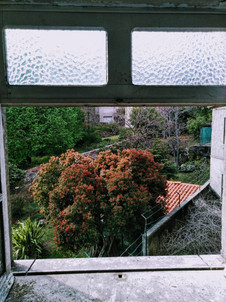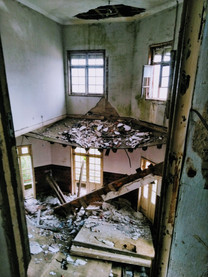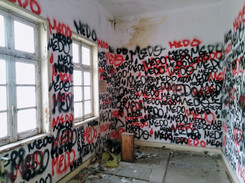Caramulo´s Sanatorial Complex
- soniamelodias

- Jun 3, 2019
- 3 min read
One of the places that my friend Cris Gonzales and I explored together was the Sanatorial Complex of Caramulo.
We went there on our return trip from Évora and we were accompanied by my husband Pedro Melo Dias, who despite negating it, ended up having fun exploring abandoned buildings with a pair of incomparable and irreplaceable (and, yes, also a little crazy ) girls: Sónia & Cris.
The history of this building, in fact buildings (there were 19 in total) dates back to 1922, the year in which the physician Jerónimo de Lacerda opened the Grande Hotel, in a place called Paredes do Guardão, which we now know as the village of Caramulo, in the municipality of Tondela. At that time, Jerónimo de Lacerda, chose the location of the hotel, due to the potential of the mountain climate to receive convalescent guests.
However, he was a very ambitious man, so after building the hotel at a height of 800 meters (which was converted into a sanatorium six years later, when it began receiving patients with tuberculosis), he gave rise to the construction of more 18 buildings (sanatoriums, infirmaries, health houses and surgery pavilions), restaurants, cafes, cinema and even a radio station. Nothing was left to chance, infrastructures were created in terms of energy, water and even a sewage network (a Berlin technician came to purposely study the best solution for the site). A network of roads was also designed (at the time the connections were very poor), gardens and orchards were planted. Forestry services were set up to do the afforestation of the sierra.
This doctor dedicated his life to Serra do Caramulo and it was thanks to him that the first steps were taken to found the village of Caramulo (the first Portuguese village to be planned from scratch), and the complex he built became the largest health resort in the Peninsula Iberica and the second at European level. The fame crossed the borders of Europe and became world-wide, because the cures were actually happening.
Jerónimo de Lacerda died in 1945, following a heart attack, and left his legacy to his children, and it was his eldest son who took control of the resort. During the 1950s, the heirs of Jerónimo de Lacerda thought they should give new life to the health complex, as the progressive eradication of the disease and the discovery of new treatments announced that the usefulness of the place might cease to exist. Thus, they tried to embark on a new branch: tourism.
However, this branch change did not allow the salvation of the Sanatorial Estate of Caramulo. For about a decade sanatoriums that used to house sick people from all over the country, were being shut down and abandoned, and after April 25, 1974, the decline was completely consummated. The last sanatorium closed it´s doors in 1986, ending a crisis that had been accentuating for decades and that was going through the degradation of the patrimony and the total economic breakdown and consequent population abandonment.
The complex buildings had different destinations:
• In the 1990s, the Salazar Sanatorium, at the time intended for members of the Army, became the four-star Hotel do Caramulo;
• The sanatorium next to it houses the Institute for the Prevention of Stress and Occupational Health;
• Sameiro, Monteiro de Carvalho, Boa Esperança and Pedras Soltas were converted into old-age homes and two other sanatoriums were converted into dwelling houses, another received patients with psychiatric problems and there is still one that is owned by Opus Dei, where retreats and meetings are held;
• but others were not as lucky; three of the buildings were demolished because there was a risk of collapse and the remaining six remained standing but forgotten, abandoned, walled and waiting for investors to bring upon better days, and there are still two others that are partially in ruins. In the children's sanatorium, for example, the structure of one of the external swings still survives and in the Pavilion of Surgery there is still a rusty medical stretcher.
The exterior
Ground Floor
Stairs
Basement
1st Floor
Fear Room










































































































































































































Comments